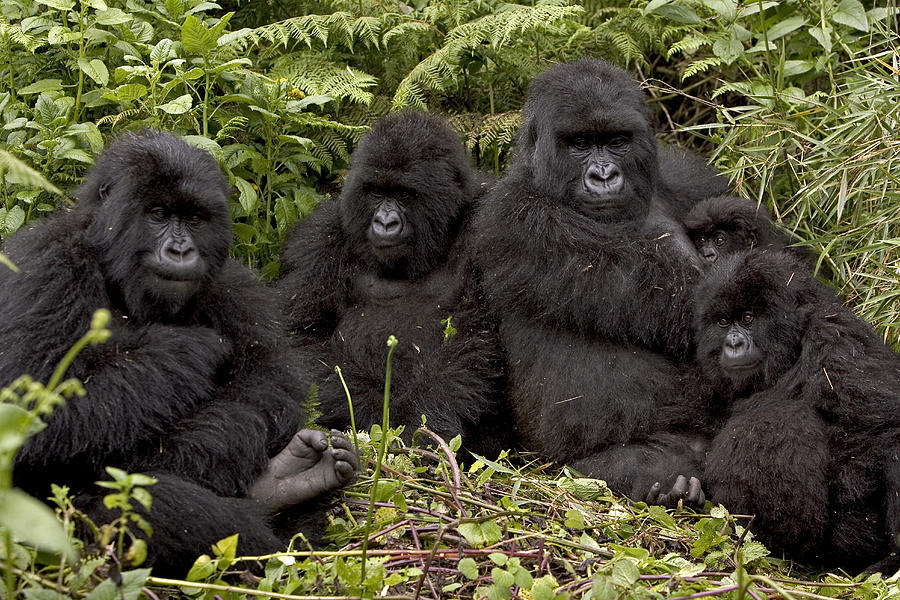How Many Gorilla Families Are in Volcanoes National Park?
Volcanoes National Park holds one of the world’s most important mountain gorilla populations. The park protects these gentle giants through a well-managed trekking system that limits visitor numbers and supports conservation. Many travelers ask how many gorilla families live in the park because this number shapes trekking availability and the overall experience. Rwanda maintains a healthy population with several habituated groups that welcome visitors each day.
The Park Hosts 12 Habituated Gorilla Families
Volcanoes National Park currently offers 12 habituated gorilla families for trekking. Each family receives one group of eight visitors per day.
These families live across the bamboo zones, hagenia forests, and volcanic slopes of the Virunga Mountains. Each group carries a unique personality, social structure, and trekking difficulty level. The 12 families create 96 daily gorilla permits, which form the core of Rwanda’s trekking system.
Why Rwanda Limits the Number of Gorilla Families for Trekking
Rwanda protects gorillas through a strict management approach. Only a select number of families are habituated to tourism.
This keeps stress low, maintains natural behavior, and protects the health of the gorillas.
The limit also ensures that the encounter remains intimate. Groups stay small, views stay clear, and trekkers enjoy a peaceful one-hour visit with the family.
The Main Gorilla Families in Volcanoes National Park
Susa Family
The Susa group gained fame through Dian Fossey’s research. The family often lives on the high slopes of Karisimbi and Bisoke. Trekkers tackle challenging terrain to reach them. Their size and history make the group one of the most iconic in the park.
Karisimbi Family
This group split from the original Susa family. They prefer high-elevation zones, so trekkers prepare for a long and demanding climb. The group lives in peaceful territories away from heavy traffic.
Sabyinyo Family
Sabyinyo holds one of the calmest silverbacks in the park. The family often stays close to the lower slopes of Mount Sabyinyo. Trekkers enjoy shorter routes when the group remains near the edge.
Amahoro Family
Amahoro means “peace.” The group lives in gentle terrain and shows calm behavior. They move between mid-altitude zones and offer rewarding encounters.
Umbano Family
Umbano split from Amahoro. The silverback leads a smaller, lively family. Their trails offer mixed terrain and moderate difficulty.
Agashya (Group 13)
Agashya moves widely across the lower slopes. The group often relocates, so trekkers follow varying routes. Their dynamic nature creates exciting trekking experiences.
Kwitonda Family
Kwitonda once stayed closer to the Uganda border, yet they moved into more central zones. Their trails pass through bamboo and Hagenia forest. The group offers steady trekking routes with moderate difficulty.

Hirwa Family
Hirwa means “lucky.” The family formed from individuals that left several groups. They often settle near the forest edges. Trekkers enjoy easy-to-moderate routes when the group remains accessible.
Bwenge Family
Bwenge stays near the slopes of Karisoke. The group’s terrain includes ridges and thick vegetation. Trekkers follow mixed routes with varying difficulty.
Titus Family
Named after Titus, one of the most studied gorillas, this family lives in the higher forest zones. They move through challenging terrain on the slopes.
Muhoza Family
Muhoza expanded over the years. They occupy zones near the foothills, giving trekkers easier access depending on daily movement.
Isimbi Family
Isimbi stays near the slopes of Mount Karisimbi. They move between bamboo and Hagenia forests. The group offers steady and scenic routes.
How Rangers Assign Gorilla Families
Rangers assign trekkers to families based on fitness level, interest, and the current position of each group. Strong families on high slopes suit experienced trekkers. Calm or lower-elevation groups suit beginners or travelers seeking short treks. Rangers make the final decision each morning after tracking teams locate the families.
Why Gorilla Families Change Over Time
Gorilla groups shift because of births, leadership changes, and territory adjustments. Families may split when young silverbacks gain maturity. New groups may form after disputes or natural separation. This dynamic social life keeps the park’s gorilla population healthy and stable.
Planning Your Gorilla Trek
Understanding the gorilla families helps you choose the best trekking experience. Whether you want an easy route or a challenging climb, Volcanoes National Park offers a family that fits your plan.
For gorilla permits, tailored trekking routes, and safari bookings, inquire and book with us at https://www.gorilla-permits.com.

